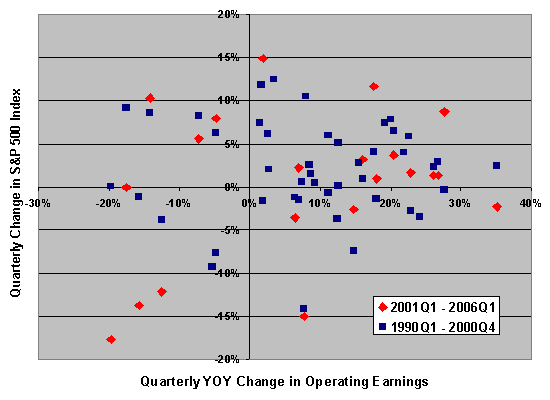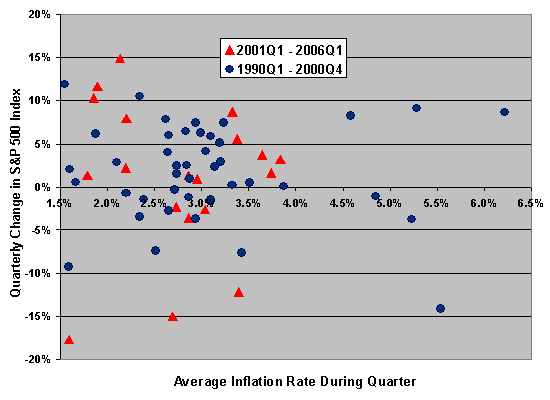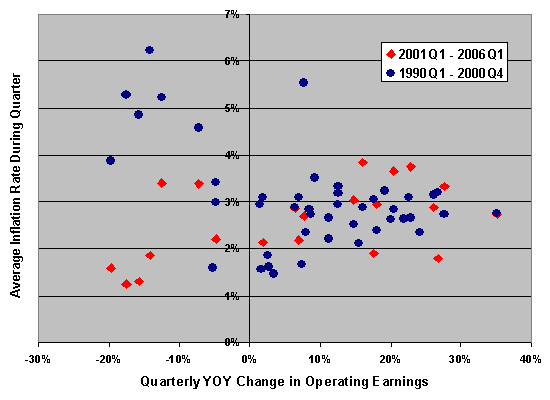In their February 2003 paper entitled “Stock Returns, Aggregate Earnings Surprises, and Behavioral Finance”, Jonathan Lewellen, S. Kothari and Jerold Warner explore the relationships between overall stock market behavior and aggregate corporate earnings, looking for parallels with firm-level price-earnings behavior. Using quarterly data for 1970-2000, they conclude that:
- Overall stock market returns are unrelated to aggregate past earnings; and,
- Overall stock market returns correlate negatively with concurrent aggregate earnings. During 1970-2000, stock prices increased by an average of 6.5% in quarters with negative earnings growth and only 1.9% otherwise.
- Earnings and discount rates may move together over time, with discount-rate shocks explaining a significant fraction of aggregate stock returns. Very high earnings tend to come with increases in the discount rate.
The following chart depicts the relationship between quarterly returns for the S&P 500 index (representing the overall stock market) and the concurrent quarterly year-over-year (YOY) changes in aggregate operating earnings for the the S&P 500 since 1990. Data inside (outside) the sample from the above study is blue (red). No relationship is apparent visually. The Pearson correlation between these two variables over the entire period is .03, further indicating no relationship. For the out-of-sample data alone, the correlation is .09. This result does not confirm the study’s conclusion that “overall stock market returns are negatively correlated with concurrent aggregate earnings.”
Note that earnings are, in fact, not released until the quarter after the concurrent quarter. However, lagging the returns by one quarter produces about the same correlations.

The next chart looks at the inflation rate (discount rate shock) aspect of the model. It depicts the relationship between quarterly returns for the S&P 500 index and the concurrent average quarterly inflation rate since 1990. Data inside (outside) the study sample is blue (red). Again, no relationship is apparent visually. The Pearson correlation between these two variables over the entire period is -.01, further indicating no relationship. For the out-of-sample data alone, the correlation is 0.11.

The final chart depicts the relationship between the average quarterly inflation rate and the concurrent quarterly YOY change in aggregate operating earnings since 1990. Data inside (outside) the study sample is blue (red). The Pearson correlation between these two variables over the entire period is -.34, indicating that there may be a relationship, though perhaps not the one expected. When we lag the inflation data by four quarters, the correlation flips to a positive .16, so perhaps high earnings growth stimulates future inflation. This results tends to confirm the study finding that “earnings and discount rates move together over time.” For the out-of-sample data alone, the concurrent correlation is -.23. When we lag the inflation data by four quarters, the correlation flips to a positive .61.

In summary, neither change in aggregate earnings nor the inflation rate alone is a good concurrent indicator for the overall stock market returns on a quarterly basis. However, because earnings growth and inflation are interrelated, they may together help forecast stock market behavior.
Note that the samples used here, especially the out-of-sample subset, are small.